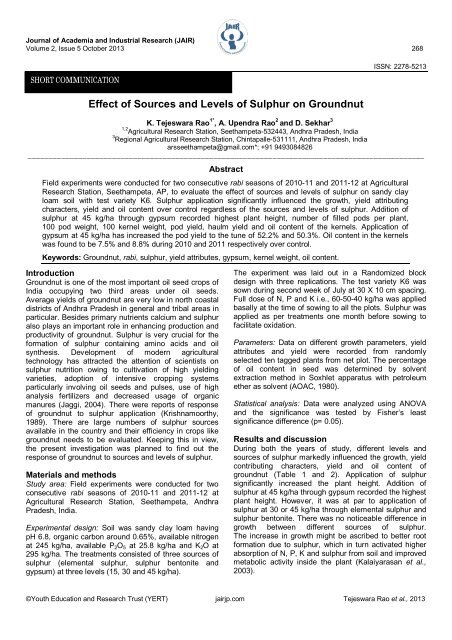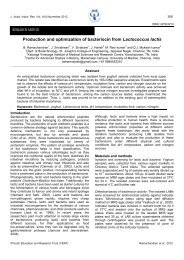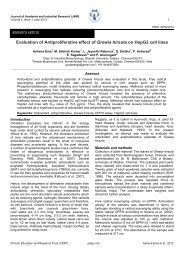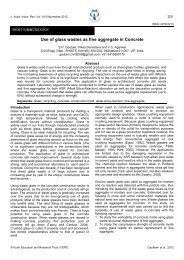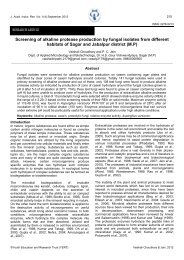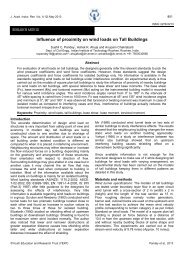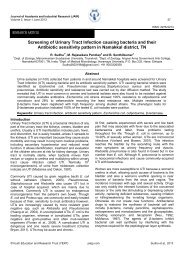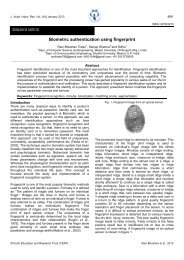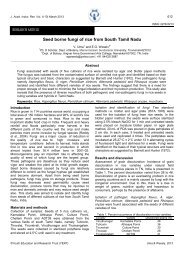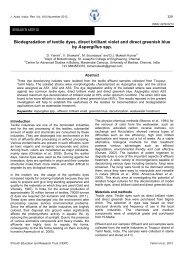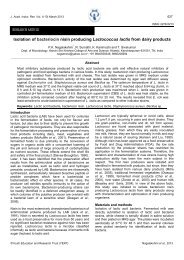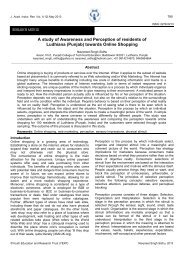Effect of Sources and Levels of Sulphur on Groundnut - Journal of ...
Effect of Sources and Levels of Sulphur on Groundnut - Journal of ...
Effect of Sources and Levels of Sulphur on Groundnut - Journal of ...
Create successful ePaper yourself
Turn your PDF publications into a flip-book with our unique Google optimized e-Paper software.
<strong>Journal</strong> <str<strong>on</strong>g>of</str<strong>on</strong>g> Academia <str<strong>on</strong>g>and</str<strong>on</strong>g> Industrial Research (JAIR)Volume 2, Issue 5 October 2013 268SHORT COMMUNICATIONISSN: 2278-5213<str<strong>on</strong>g>Effect</str<strong>on</strong>g> <str<strong>on</strong>g>of</str<strong>on</strong>g> <str<strong>on</strong>g>Sources</str<strong>on</strong>g> <str<strong>on</strong>g>and</str<strong>on</strong>g> <str<strong>on</strong>g>Levels</str<strong>on</strong>g> <str<strong>on</strong>g>of</str<strong>on</strong>g> <str<strong>on</strong>g>Sulphur</str<strong>on</strong>g> <strong>on</strong> <strong>Groundnut</strong>K. Tejeswara Rao 1* , A. Upendra Rao 2 <str<strong>on</strong>g>and</str<strong>on</strong>g> D. Sekhar 31,2 Agricultural Research Stati<strong>on</strong>, Seethampeta-532443, Andhra Pradesh, India3 Regi<strong>on</strong>al Agricultural Research Stati<strong>on</strong>, Chintapalle-531111, Andhra Pradesh, Indiaarsseethampeta@gmail.com*; +91 9493084826______________________________________________________________________________________________AbstractField experiments were c<strong>on</strong>ducted for two c<strong>on</strong>secutive rabi seas<strong>on</strong>s <str<strong>on</strong>g>of</str<strong>on</strong>g> 2010-11 <str<strong>on</strong>g>and</str<strong>on</strong>g> 2011-12 at AgriculturalResearch Stati<strong>on</strong>, Seethampeta, AP, to evaluate the effect <str<strong>on</strong>g>of</str<strong>on</strong>g> sources <str<strong>on</strong>g>and</str<strong>on</strong>g> levels <str<strong>on</strong>g>of</str<strong>on</strong>g> sulphur <strong>on</strong> s<str<strong>on</strong>g>and</str<strong>on</strong>g>y clayloam soil with test variety K6. <str<strong>on</strong>g>Sulphur</str<strong>on</strong>g> applicati<strong>on</strong> significantly influenced the growth, yield attributingcharacters, yield <str<strong>on</strong>g>and</str<strong>on</strong>g> oil c<strong>on</strong>tent over c<strong>on</strong>trol regardless <str<strong>on</strong>g>of</str<strong>on</strong>g> the sources <str<strong>on</strong>g>and</str<strong>on</strong>g> levels <str<strong>on</strong>g>of</str<strong>on</strong>g> sulphur. Additi<strong>on</strong> <str<strong>on</strong>g>of</str<strong>on</strong>g>sulphur at 45 kg/ha through gypsum recorded highest plant height, number <str<strong>on</strong>g>of</str<strong>on</strong>g> filled pods per plant,100 pod weight, 100 kernel weight, pod yield, haulm yield <str<strong>on</strong>g>and</str<strong>on</strong>g> oil c<strong>on</strong>tent <str<strong>on</strong>g>of</str<strong>on</strong>g> the kernels. Applicati<strong>on</strong> <str<strong>on</strong>g>of</str<strong>on</strong>g>gypsum at 45 kg/ha has increased the pod yield to the tune <str<strong>on</strong>g>of</str<strong>on</strong>g> 52.2% <str<strong>on</strong>g>and</str<strong>on</strong>g> 50.3%. Oil c<strong>on</strong>tent in the kernelswas found to be 7.5% <str<strong>on</strong>g>and</str<strong>on</strong>g> 8.8% during 2010 <str<strong>on</strong>g>and</str<strong>on</strong>g> 2011 respectively over c<strong>on</strong>trol.Keywords: <strong>Groundnut</strong>, rabi, sulphur, yield attributes, gypsum, kernel weight, oil c<strong>on</strong>tent.Introducti<strong>on</strong><strong>Groundnut</strong> is <strong>on</strong>e <str<strong>on</strong>g>of</str<strong>on</strong>g> the most important oil seed crops <str<strong>on</strong>g>of</str<strong>on</strong>g>India occupying two third areas under oil seeds.Average yields <str<strong>on</strong>g>of</str<strong>on</strong>g> groundnut are very low in north coastaldistricts <str<strong>on</strong>g>of</str<strong>on</strong>g> Andhra Pradesh in general <str<strong>on</strong>g>and</str<strong>on</strong>g> tribal areas inparticular. Besides primary nutrients calcium <str<strong>on</strong>g>and</str<strong>on</strong>g> sulphuralso plays an important role in enhancing producti<strong>on</strong> <str<strong>on</strong>g>and</str<strong>on</strong>g>productivity <str<strong>on</strong>g>of</str<strong>on</strong>g> groundnut. <str<strong>on</strong>g>Sulphur</str<strong>on</strong>g> is very crucial for theformati<strong>on</strong> <str<strong>on</strong>g>of</str<strong>on</strong>g> sulphur c<strong>on</strong>taining amino acids <str<strong>on</strong>g>and</str<strong>on</strong>g> oilsynthesis. Development <str<strong>on</strong>g>of</str<strong>on</strong>g> modern agriculturaltechnology has attracted the attenti<strong>on</strong> <str<strong>on</strong>g>of</str<strong>on</strong>g> scientists <strong>on</strong>sulphur nutriti<strong>on</strong> owing to cultivati<strong>on</strong> <str<strong>on</strong>g>of</str<strong>on</strong>g> high yieldingvarieties, adopti<strong>on</strong> <str<strong>on</strong>g>of</str<strong>on</strong>g> intensive cropping systemsparticularly involving oil seeds <str<strong>on</strong>g>and</str<strong>on</strong>g> pulses, use <str<strong>on</strong>g>of</str<strong>on</strong>g> highanalysis fertilizers <str<strong>on</strong>g>and</str<strong>on</strong>g> decreased usage <str<strong>on</strong>g>of</str<strong>on</strong>g> organicmanures (Jaggi, 2004). There were reports <str<strong>on</strong>g>of</str<strong>on</strong>g> resp<strong>on</strong>se<str<strong>on</strong>g>of</str<strong>on</strong>g> groundnut to sulphur applicati<strong>on</strong> (Krishnamoorthy,1989). There are large numbers <str<strong>on</strong>g>of</str<strong>on</strong>g> sulphur sourcesavailable in the country <str<strong>on</strong>g>and</str<strong>on</strong>g> their efficiency in crops likegroundnut needs to be evaluated. Keeping this in view,the present investigati<strong>on</strong> was planned to find out theresp<strong>on</strong>se <str<strong>on</strong>g>of</str<strong>on</strong>g> groundnut to sources <str<strong>on</strong>g>and</str<strong>on</strong>g> levels <str<strong>on</strong>g>of</str<strong>on</strong>g> sulphur.Materials <str<strong>on</strong>g>and</str<strong>on</strong>g> methodsStudy area: Field experiments were c<strong>on</strong>ducted for twoc<strong>on</strong>secutive rabi seas<strong>on</strong>s <str<strong>on</strong>g>of</str<strong>on</strong>g> 2010-11 <str<strong>on</strong>g>and</str<strong>on</strong>g> 2011-12 atAgricultural Research Stati<strong>on</strong>, Seethampeta, AndhraPradesh, India.Experimental design: Soil was s<str<strong>on</strong>g>and</str<strong>on</strong>g>y clay loam havingpH 6.8, organic carb<strong>on</strong> around 0.65%, available nitrogenat 245 kg/ha, available P 2 O 5 at 25.8 kg/ha <str<strong>on</strong>g>and</str<strong>on</strong>g> K 2 O at295 kg/ha. The treatments c<strong>on</strong>sisted <str<strong>on</strong>g>of</str<strong>on</strong>g> three sources <str<strong>on</strong>g>of</str<strong>on</strong>g>sulphur (elemental sulphur, sulphur bent<strong>on</strong>ite <str<strong>on</strong>g>and</str<strong>on</strong>g>gypsum) at three levels (15, 30 <str<strong>on</strong>g>and</str<strong>on</strong>g> 45 kg/ha).The experiment was laid out in a R<str<strong>on</strong>g>and</str<strong>on</strong>g>omized blockdesign with three replicati<strong>on</strong>s. The test variety K6 wassown during sec<strong>on</strong>d week <str<strong>on</strong>g>of</str<strong>on</strong>g> July at 30 X 10 cm spacing.Full dose <str<strong>on</strong>g>of</str<strong>on</strong>g> N, P <str<strong>on</strong>g>and</str<strong>on</strong>g> K i.e., 60-50-40 kg/ha was appliedbasally at the time <str<strong>on</strong>g>of</str<strong>on</strong>g> sowing to all the plots. <str<strong>on</strong>g>Sulphur</str<strong>on</strong>g> wasapplied as per treatments <strong>on</strong>e m<strong>on</strong>th before sowing t<str<strong>on</strong>g>of</str<strong>on</strong>g>acilitate oxidati<strong>on</strong>.Parameters: Data <strong>on</strong> different growth parameters, yieldattributes <str<strong>on</strong>g>and</str<strong>on</strong>g> yield were recorded from r<str<strong>on</strong>g>and</str<strong>on</strong>g>omlyselected ten tagged plants from net plot. The percentage<str<strong>on</strong>g>of</str<strong>on</strong>g> oil c<strong>on</strong>tent in seed was determined by solventextracti<strong>on</strong> method in Soxhlet apparatus with petroleumether as solvent (AOAC, 1980).Statistical analysis: Data were analyzed using ANOVA<str<strong>on</strong>g>and</str<strong>on</strong>g> the significance was tested by Fisher’s leastsignificance difference (p= 0.05).Results <str<strong>on</strong>g>and</str<strong>on</strong>g> discussi<strong>on</strong>During both the years <str<strong>on</strong>g>of</str<strong>on</strong>g> study, different levels <str<strong>on</strong>g>and</str<strong>on</strong>g>sources <str<strong>on</strong>g>of</str<strong>on</strong>g> sulphur markedly influenced the growth, yieldc<strong>on</strong>tributing characters, yield <str<strong>on</strong>g>and</str<strong>on</strong>g> oil c<strong>on</strong>tent <str<strong>on</strong>g>of</str<strong>on</strong>g>groundnut (Table 1 <str<strong>on</strong>g>and</str<strong>on</strong>g> 2). Applicati<strong>on</strong> <str<strong>on</strong>g>of</str<strong>on</strong>g> sulphursignificantly increased the plant height. Additi<strong>on</strong> <str<strong>on</strong>g>of</str<strong>on</strong>g>sulphur at 45 kg/ha through gypsum recorded the highestplant height. However, it was at par to applicati<strong>on</strong> <str<strong>on</strong>g>of</str<strong>on</strong>g>sulphur at 30 or 45 kg/ha through elemental sulphur <str<strong>on</strong>g>and</str<strong>on</strong>g>sulphur bent<strong>on</strong>ite. There was no noticeable difference ingrowth between different sources <str<strong>on</strong>g>of</str<strong>on</strong>g> sulphur.The increase in growth might be ascribed to better rootformati<strong>on</strong> due to sulphur, which in turn activated higherabsorpti<strong>on</strong> <str<strong>on</strong>g>of</str<strong>on</strong>g> N, P, K <str<strong>on</strong>g>and</str<strong>on</strong>g> sulphur from soil <str<strong>on</strong>g>and</str<strong>on</strong>g> improvedmetabolic activity inside the plant (Kalaiyarasan et al.,2003).©Youth Educati<strong>on</strong> <str<strong>on</strong>g>and</str<strong>on</strong>g> Research Trust (YERT) jairjp.com Tejeswara Rao et al., 2013
<strong>Journal</strong> <str<strong>on</strong>g>of</str<strong>on</strong>g> Academia <str<strong>on</strong>g>and</str<strong>on</strong>g> Industrial Research (JAIR)Volume 2, Issue 5 October 2013 269Table 1. <str<strong>on</strong>g>Effect</str<strong>on</strong>g> <str<strong>on</strong>g>of</str<strong>on</strong>g> sources <str<strong>on</strong>g>and</str<strong>on</strong>g> levels <str<strong>on</strong>g>of</str<strong>on</strong>g> sulphur <strong>on</strong> plant height <str<strong>on</strong>g>and</str<strong>on</strong>g> yield attributes <str<strong>on</strong>g>of</str<strong>on</strong>g> groundnut.TreatmentPlant height(cm)No. <str<strong>on</strong>g>of</str<strong>on</strong>g> filledpods/plant100 podWt. (g)100 kernelWt. (g)2010 2011 2010 2011 2010 2011 2010 2011T1-15 kg S through elemental sulphur 63.11 64.26 16.45 15.68 74.35 75.92 35.35 36.78T2-30 kg S through elemental sulphur 66.60 68.08 16.77 16.14 75.73 76.47 38.32 38.27T3-45 kg S through elemental sulphur 68.85 69.35 17.93 17.83 75.74 77.19 39.04 39.54T4-15 kg S through sulphur bent<strong>on</strong>ite 63.73 64.29 16.91 14.78 74.72 76.86 36.13 37.00T5-30 kg S through sulphur bent<strong>on</strong>ite 65.87 66.75 17.49 15.65 76.68 77.57 39.27 38.12T6- 45 kg S through sulphur bent<strong>on</strong>ite 68.11 67.93 17.74 16.89 77.37 78.13 39.63 38.93T7-15 kg S through gypsum 64.78 65.50 18.00 17.42 77.03 78.20 37.39 38.74T8-30 kg S through gypsum 68.90 69.07 18.27 18.67 77.72 79.42 39.37 39.09T9- 45 kg S through gypsum 70.66 71.45 18.03 19.33 79.08 80.77 40.05 40.78T10-C<strong>on</strong>trol (No S applicati<strong>on</strong>) 61.12 60.74 13.20 12.94 70.09 71.15 32.03 33.91SEM + 1.65 1.83 0.47 0.74 1.62 1.31 0.71 0.77CD @ 5% 4.91 5.43 1.27 1.49 4.78 3.69 2.14 2.23Table 2. <str<strong>on</strong>g>Effect</str<strong>on</strong>g> <str<strong>on</strong>g>of</str<strong>on</strong>g> sources <str<strong>on</strong>g>and</str<strong>on</strong>g> levels <str<strong>on</strong>g>of</str<strong>on</strong>g> sulphur <strong>on</strong> yield, shelling <str<strong>on</strong>g>and</str<strong>on</strong>g> oil outturn <str<strong>on</strong>g>of</str<strong>on</strong>g> groundnut.TreatmentPod yield(Kg/ha)Haulm yield(Kg/ha)Shelling(%)Oil c<strong>on</strong>tent(%)2010 2011 2010 2011 2010 2011 2010 2011T1-15 kg S through elemental sulphur 895 880 1521 1610 64.82 65.17 48.50 48.57T2-30 kg S through elemental sulphur 997 991 1619 1691 66.37 66.79 48.63 48.97T3-45 kg S through elemental sulphur 1045 1026 1710 1758 68.90 68.42 49.23 49.57T4-15 kg S through sulphur bent<strong>on</strong>ite 886 878 1574 1567 65.03 65.23 48.07 47.50T5-30 kg S through sulphur bent<strong>on</strong>ite 982 948 1650 1677 67.05 67.37 48.57 48.60T6- 45 kg S through sulphur bent<strong>on</strong>ite 1038 1011 1736 1791 67.29 67.74 49.20 49.07T7-15 kg S through gypsum 1005 986 1673 1638 67.37 67.61 48.97 48.77T8-30 kg S through gypsum 1132 1102 1786 1792 68.11 68.45 49.53 49.67T9- 45 kg S through gypsum 1215 1204 1822 1874 68.65 69.09 50.17 49.93T10-C<strong>on</strong>trol (No S applicati<strong>on</strong>) 798 801 1477 1509 63.37 62.70 46.65 45.89SEM + 25.25 22.90 54.88 57.24 0.54 0.71 0.28 0.32CD @ 5% 75 68 163 170 1.59 2.11 0.82 0.94<str<strong>on</strong>g>Sulphur</str<strong>on</strong>g> applicati<strong>on</strong> significantly influenced all the yieldattributing characters regardless <str<strong>on</strong>g>of</str<strong>on</strong>g> the sources <str<strong>on</strong>g>and</str<strong>on</strong>g>levels <str<strong>on</strong>g>of</str<strong>on</strong>g> sulphur applicati<strong>on</strong> over c<strong>on</strong>trol. Applicati<strong>on</strong> <str<strong>on</strong>g>of</str<strong>on</strong>g>sulphur at 15 kg or more/ha c<strong>on</strong>spicuously augmented allthe yield c<strong>on</strong>tributing characters. Additi<strong>on</strong> <str<strong>on</strong>g>of</str<strong>on</strong>g> sulphur at45 kg/ha through gypsum recorded highest number <str<strong>on</strong>g>of</str<strong>on</strong>g>filled pods per plant <str<strong>on</strong>g>and</str<strong>on</strong>g> which was <strong>on</strong> par with theremaining sources <str<strong>on</strong>g>of</str<strong>on</strong>g> sulphur at same level <str<strong>on</strong>g>of</str<strong>on</strong>g>applicati<strong>on</strong>. Both 100 pod weight <str<strong>on</strong>g>and</str<strong>on</strong>g> 100 kernel weightalso improved significantly with the applicati<strong>on</strong> <str<strong>on</strong>g>of</str<strong>on</strong>g> sulphurat 45 kg/ha through gypsum. Pod yield increasedsignificantly with sulphur applicati<strong>on</strong> at 15 kg or more/hairrespective <str<strong>on</strong>g>of</str<strong>on</strong>g> sources over c<strong>on</strong>trol. Applicati<strong>on</strong> <str<strong>on</strong>g>of</str<strong>on</strong>g>gypsum at 45 kg/ha resulted in highest pod yieldcompared to all other sources <str<strong>on</strong>g>and</str<strong>on</strong>g> levels <str<strong>on</strong>g>of</str<strong>on</strong>g> sulphurapplicati<strong>on</strong>. Applicati<strong>on</strong> <str<strong>on</strong>g>of</str<strong>on</strong>g> gypsum at 45 kg/ha hasincreased the pod yield to the tune <str<strong>on</strong>g>of</str<strong>on</strong>g> 52.2%, 50.3%during 2010 <str<strong>on</strong>g>and</str<strong>on</strong>g> 2011 respectively over c<strong>on</strong>trol.Supply <str<strong>on</strong>g>of</str<strong>on</strong>g> sulphur through gypsum showed an edge overother sources. Haulm yield was also found similar to that<str<strong>on</strong>g>of</str<strong>on</strong>g> pod yield. Improvement in yield might have resultedfrom favorable influence <str<strong>on</strong>g>of</str<strong>on</strong>g> sulphur <strong>on</strong> growth <str<strong>on</strong>g>and</str<strong>on</strong>g>efficient partiti<strong>on</strong>ing <str<strong>on</strong>g>and</str<strong>on</strong>g> translocati<strong>on</strong> <str<strong>on</strong>g>of</str<strong>on</strong>g> metabolites toreproductive structures.Favorable effect <str<strong>on</strong>g>of</str<strong>on</strong>g> sulphur applicati<strong>on</strong> was noticed <strong>on</strong>shelling percent also where supply <str<strong>on</strong>g>of</str<strong>on</strong>g> sulphur at 15 kg ormore/ha improved shelling percent. Similar results <str<strong>on</strong>g>of</str<strong>on</strong>g>higher growth, yield attributes pod yield <str<strong>on</strong>g>and</str<strong>on</strong>g> shelling outturn were also reported by Chitkala <str<strong>on</strong>g>and</str<strong>on</strong>g> Reddy (1991)<str<strong>on</strong>g>and</str<strong>on</strong>g> Kalaiyarasan et al. (2003).<str<strong>on</strong>g>Sulphur</str<strong>on</strong>g> applicati<strong>on</strong> improved the oil c<strong>on</strong>tent <str<strong>on</strong>g>of</str<strong>on</strong>g> the kernelsignificantly. Additi<strong>on</strong> <str<strong>on</strong>g>of</str<strong>on</strong>g> sulphur at 45 kg/ha throughgypsum registered highest oil c<strong>on</strong>tent, however it wasfound at par to applicati<strong>on</strong> <str<strong>on</strong>g>of</str<strong>on</strong>g> sulphur at 30 kg/ha throughgypsum, applicati<strong>on</strong> <str<strong>on</strong>g>of</str<strong>on</strong>g> sulphur at 45 kg/ha throughelemental sulphur <str<strong>on</strong>g>and</str<strong>on</strong>g> sulphur bent<strong>on</strong>ite. Applicati<strong>on</strong> <str<strong>on</strong>g>of</str<strong>on</strong>g>gypsum at 45 kg/ha has increased the percent oil c<strong>on</strong>tentin the kernels by 7.5 <str<strong>on</strong>g>and</str<strong>on</strong>g> 8.8% during 2010 <str<strong>on</strong>g>and</str<strong>on</strong>g> 2011over c<strong>on</strong>trol. Improvement in oil c<strong>on</strong>tent with sulphurapplicati<strong>on</strong> might be due to involvement <str<strong>on</strong>g>of</str<strong>on</strong>g> sulphurdirectly in oil synthesis. Higher yield <str<strong>on</strong>g>and</str<strong>on</strong>g> oil c<strong>on</strong>tent withincreased applicati<strong>on</strong> <str<strong>on</strong>g>of</str<strong>on</strong>g> sulphur also attributed protein<str<strong>on</strong>g>and</str<strong>on</strong>g> enzyme synthesis as it is a c<strong>on</strong>stituent <str<strong>on</strong>g>of</str<strong>on</strong>g> sulphurc<strong>on</strong>taining amino acids namely meth<strong>on</strong>ine, cysteine <str<strong>on</strong>g>and</str<strong>on</strong>g>cystine (Kumar et al., 2011).©Youth Educati<strong>on</strong> <str<strong>on</strong>g>and</str<strong>on</strong>g> Research Trust (YERT) jairjp.com Tejeswara Rao et al., 2013
<strong>Journal</strong> <str<strong>on</strong>g>of</str<strong>on</strong>g> Academia <str<strong>on</strong>g>and</str<strong>on</strong>g> Industrial Research (JAIR)Volume 2, Issue 5 October 2013 270C<strong>on</strong>clusi<strong>on</strong><str<strong>on</strong>g>Sulphur</str<strong>on</strong>g> applicati<strong>on</strong> significantly influenced the growth,yield attributing characters <str<strong>on</strong>g>and</str<strong>on</strong>g> yield over c<strong>on</strong>trolregardless <str<strong>on</strong>g>of</str<strong>on</strong>g> the sources <str<strong>on</strong>g>and</str<strong>on</strong>g> levels <str<strong>on</strong>g>of</str<strong>on</strong>g> sulphurapplicati<strong>on</strong>. Additi<strong>on</strong> <str<strong>on</strong>g>of</str<strong>on</strong>g> sulphur at 45 kg/ha throughgypsum recorded the highest plant height, number <str<strong>on</strong>g>of</str<strong>on</strong>g>filled pods per plant, 100 pod weight ,100 kernel weight,pod yield, haulm yield <str<strong>on</strong>g>and</str<strong>on</strong>g> oil c<strong>on</strong>tent <str<strong>on</strong>g>of</str<strong>on</strong>g> the kernels.References1. AOAC. 1980. Official methods <str<strong>on</strong>g>of</str<strong>on</strong>g> analysis, 13 th ed.Associati<strong>on</strong> <str<strong>on</strong>g>of</str<strong>on</strong>g> <str<strong>on</strong>g>of</str<strong>on</strong>g>ficial Oil Analytical chemists.Washingt<strong>on</strong> D.C. pp.376-384.2. Chitkala, T.D. <str<strong>on</strong>g>and</str<strong>on</strong>g> Reddy, M.G.R. 1991. <str<strong>on</strong>g>Effect</str<strong>on</strong>g> <str<strong>on</strong>g>of</str<strong>on</strong>g> sulphur<strong>on</strong> growth, yield <str<strong>on</strong>g>and</str<strong>on</strong>g> oil outturn in groundnut. Ind. J.Agr<strong>on</strong>. 36(2): 265-266.3. Jaggi, R.C. 2004. <str<strong>on</strong>g>Effect</str<strong>on</strong>g> <str<strong>on</strong>g>of</str<strong>on</strong>g> sulphur levels <str<strong>on</strong>g>and</str<strong>on</strong>g> sources <strong>on</strong>compositi<strong>on</strong> <str<strong>on</strong>g>and</str<strong>on</strong>g> yield <str<strong>on</strong>g>of</str<strong>on</strong>g> <strong>on</strong>i<strong>on</strong>. Ind. J. Agric. Sci. 74(4):219-220.4. Kalaiyarasan, C., Vaiyapuri, V. <str<strong>on</strong>g>and</str<strong>on</strong>g> Ch<str<strong>on</strong>g>and</str<strong>on</strong>g>rasekharan,M.V.S. 2003. <str<strong>on</strong>g>Effect</str<strong>on</strong>g> <str<strong>on</strong>g>of</str<strong>on</strong>g> sulphur sources <str<strong>on</strong>g>and</str<strong>on</strong>g> levels <strong>on</strong> thenutrient uptake, crop quality <str<strong>on</strong>g>and</str<strong>on</strong>g> sulphur use efficiency ingroundnut. Ann. Agric. Res. New Series. 24(3): 478-480.5. Krishnamoorthy, S.K. 1989. <str<strong>on</strong>g>Sulphur</str<strong>on</strong>g> fertilizati<strong>on</strong> for yield<str<strong>on</strong>g>and</str<strong>on</strong>g> quality <str<strong>on</strong>g>of</str<strong>on</strong>g> crops. Proc. Nat. Seminar <strong>on</strong> <str<strong>on</strong>g>Sulphur</str<strong>on</strong>g> inAgriculture, held at UAS, Bangalore. pp.22-25.6. Kumar, S., Tewari, S.K. <str<strong>on</strong>g>and</str<strong>on</strong>g> Singh, S.S. 2011. <str<strong>on</strong>g>Effect</str<strong>on</strong>g> <str<strong>on</strong>g>of</str<strong>on</strong>g>sources <str<strong>on</strong>g>and</str<strong>on</strong>g> levels <str<strong>on</strong>g>of</str<strong>on</strong>g> sulphur <strong>on</strong> growth yield <str<strong>on</strong>g>and</str<strong>on</strong>g> quality<str<strong>on</strong>g>of</str<strong>on</strong>g> sunflower. Ind. J. Agr<strong>on</strong>. 56(3): 242-246.©Youth Educati<strong>on</strong> <str<strong>on</strong>g>and</str<strong>on</strong>g> Research Trust (YERT) jairjp.com Tejeswara Rao et al., 2013


